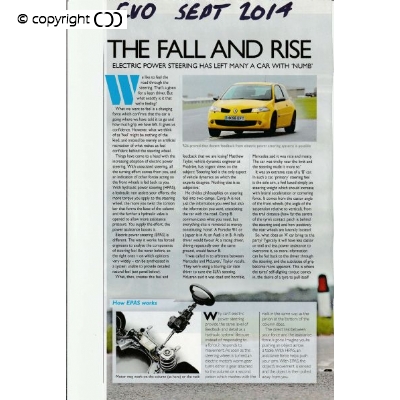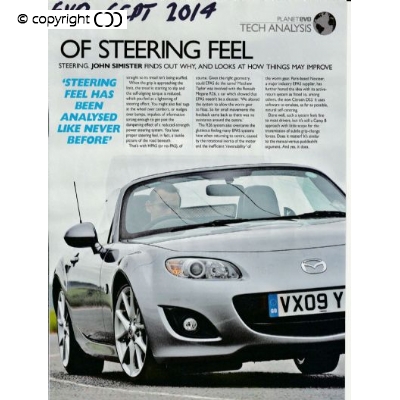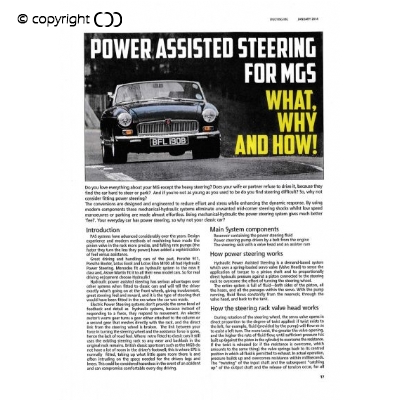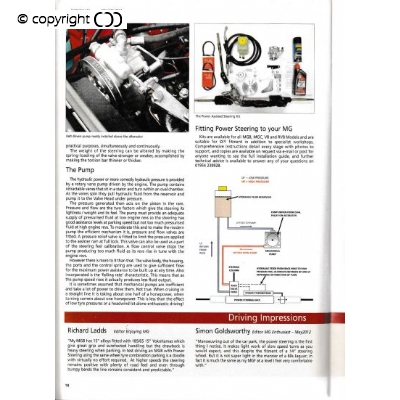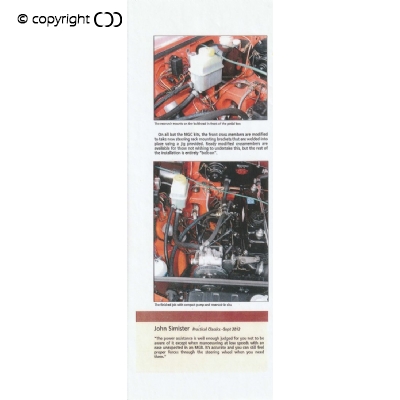Information & Background to Power Assisted Steering
PAS
BACKGROUND ON THE TYPES OF POWER ASSISTED STEERING
Just as aircraft are not made of wood and canvas anymore hydraulic PAS systems have advanced. Design experience and modern methods of machining have made the pinion valve more precise, falling rate pumps (the faster they turn the less they produce) have added a sophistication of feel versus assistance. Other systems can do the job but not nearly so well.
Great driving and handling cars of the past, Porsche 911, Porsche Boxter, Lotus Excel and Lotus Elan M100 all had Hydraulic Power Steering. Lotus use an hydraulic system for the Evora; Mercedes fit an hydraulic system to the new E class and the SLS and SLS AMG, Aston Martin until recently to all their cars, Nissan fit it to the GTR, Ferrari to the 458 and the greatest 2 seater of the last 15 years, the MX5 also has Hydraulic Power Steering.
The reasons that EPAS are fitted is because during emission tests the steering is not operating and not drawing any power giving a minute reduction in CO emission, and it is easier to fit on the production line.
Hydraulic power assisted steering has serious advantages over other systems when fitted to classic cars and will tell the driver exactly what’s going on at the front wheels, giving involvement, great steering feel and reward and it is the type of steering that would have been fitted when the car was made.
Other advantages are: no foot well intrusion, no extra strain on the vehicle electrics, new steering rack with less turns lock to lock.
If hydraulic power steering is seen to have a draw back it is the fact that the pump in running all the time, in fact this is what gives the system its immediacy, its feel and its responsiveness. The ’extra' fuel used is less than may be caused by a headwind or low tyre pressures let alone enthusiastic driving!
Until very recently no Electric Power Assisted Steering (EPAS) system has had any real feel, only now have the large manufacturers artificially built in feel, by using signals form the multiple of sensors ( 50+) and the CAN / LAN wiring systems (CAN = Central Area Network LAN = Local Area Network) feeding into the EPAS’s dedicated ECU, some more successfully than others. And the fact is that classic cars do not have this electrical architecture so can not have the ‘feel’ artificially created.
When EPS is retro fitted to classic cars it still uses the existing steering box or rack. These have the original number of turns from lock to lock and do not take the advantage of being able to ‘quicken’ the steering towards the ‘ideal’ 2.8 turns lock to lock, also the wear and backlash in the original system remains.
British classic cars such as Triumph TR, MGB, Morgan do not have a lot of room under the dashboard and in the driver’s footwell; this is where EPS is fitted, taking up what little spare room there is and often intruding on the space needed for the drivers legs and knees. This has to be considered hazardous in the event of an accident and compromises comfortable every day driving.
Although the EPS system may come with its own wiring it still has to draw its considerable currant demand of 45 to 90 amps from somewhere, be it battery or alternator, both of which may need uprating if driven a lot in town / city.
A modern Mechanical Hydraulic PAS system is a better, more driver orientated, more understandable and appropriate system for a rear wheel drive classic sports car. So for real driving enjoyment choose Hydraulic!
BRIEF EXPLAINATION OF THE VARIOUS TYPES OF POWER ASSISTED STEERING
Mechanical Hydraulic Power Assisted Steering (MHPAS) Engine driven pump delivering fluid to an hydraulically assisted steering rack.
Electro Hydraulic Power Assisted Steering (EHPAS Electric motor driven pump delivering fluid to an hydraulically assisted steering rack.
Electric Power Assisted Steering (EPAS) Electric motor helping to turn, through gears, the steering column or sometimes the steering rack.
Power Steering (PS) No mechanical linkage between steering wheel and road wheels.
Steering is accomplished by a remote unit sending electric current or hydraulic pressure to the steering mechanism which moves the road wheels.
Power Assisted Steering (PAS) There is a mechanical connection from the steering wheel to the road wheels; this connection is assisted in turning by electric current or hydraulic pressure.

